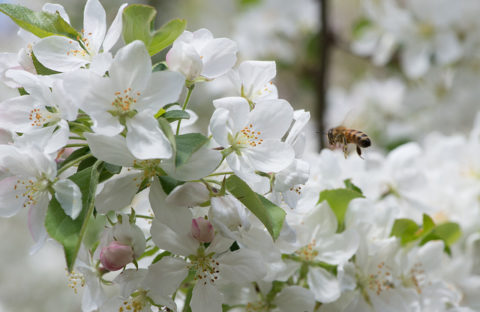
Get a good start to the gardening season with early spring tree care. Dwight Sipler photo.
It’s spring, and delicate pink and white blossoms are appearing on many trees. Ah, the fragrance of a flowering cherry!
Early spring is the time to prepare your trees for healthy growth this season. Get a head start on preventing pests and diseases on fruit trees and other susceptible trees.
Here are some spring tree care tips.
Tree care: cleanup and mulch
Clean up fallen leaves, dead plants and other debris around the base of your tree. This removes sources of overwintering pests and diseases. And it helps to prevent new pests and diseases. Clean up weeds so they don’t compete with the tree for water and nutrients.
Lay down a thick layer (2-4 inches) of mulch, such as arborist chips, pine needles or bark. The mulch will reduce future weeds. It will also reduce watering needs over the growing season. And a bark made from organic matter will feed the soil (and the tree) slowly over time.
Keep the mulch at least six inches away from the trunk. This allows the tree to get air so it won’t rot.
Here is an article from the International Society of Arboriculture with information on proper mulching techniques.
Tree care: disease prevention
Weather plays an important role in diseases. A cool, wet spring that lasts into May will likely lead to disease problems in many trees and other plants. A spring that dries out and has warm, sunny periods will result in fewer disease problems in the landscape.
In early spring we may apply fosphite to our clients’ trees to combat diseases. This is an OMRI fungicide (certified for organic use). We primarily use it on fruit trees and dogwood trees.
Fosphite is absorbed through the bark into the tree. The plant thinks it is under attack and boosts its defense mechanisms. We have seen dramatic results in managing diseases with this product.
Tree care: insect prevention
If you are a tree care client, we may have already applied dormant oil. This is a mineral oil-based product, designed for use on trees. It suffocates overwintering insects and their eggs, such as aphids, scales and mites.
If you have an apple tree, there is a good chance that it is infested with codling moth and/or apple maggot. Both insects are a big problem in western Washington.
One way to address the problem is with fruit booties. They are time-consuming to use because you must attach a bootie to each individual young apple. (Ciscoe Morris calls putting on fruit booties a “zen experience.”)
Local experience shows that booties can be very effective against codling moth. If soaked in kaolin clay before applying, they can also protect against apple maggot.
Find out more about apple pests and how to use booties in this video with local gardening expert Ciscoe Morris. The video was produced for the nonprofit group City Fruit.
One of our YouTube playlists also has several other City Fruit videos on apple tree care, such as choosing the right tree, pruning, managing diseases and more.
Tree care: pollinators
With the continued cool weather, there is still time to add mason bees to your yard to help increase pollination of your fruit trees and other plants. See our recent blog post about mason bees.
